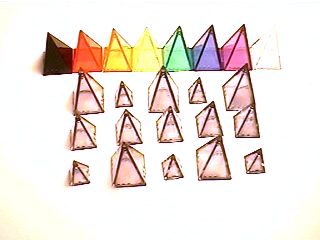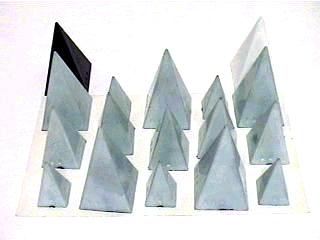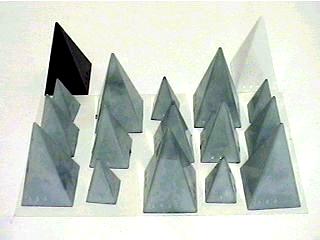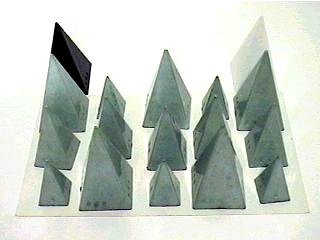Dyed Plastic Pyramids
Factory Perfect Pyramids in Custom Colors


December 2001


December 2001
It's a little known fact outside of the craft world that Rit® Dye, the same dye used by most people to tie-dye fabric, is also effective on plastic. This means that if you have a stash of clear pieces and a package of dye, you can turn that colorless stash any one of the 35 different colors that Rit sells, or any of dozens more possible through mixing.
Well, that's the theory anyway. In practice, the plastic used in the pyramids doesn't absorb the color the same way cloth would. I tried dying pyramids with two different colors.
 My first try was using black dye to make "smoked" pieces.
These came out a very nice shade of teal.
Interesting, but not "smoke".
My first try was using black dye to make "smoked" pieces.
These came out a very nice shade of teal.
Interesting, but not "smoke".
 My second try was using a mixture of yellow and purple to make brown pieces.
These came out a very light "slate blue" color.
Again, interesting, but not what I wanted.
My second try was using a mixture of yellow and purple to make brown pieces.
These came out a very light "slate blue" color.
Again, interesting, but not what I wanted.
To get darker colors than I achieved, you have basically three options:
 Those first two are dangerous.
If the pieces get too hot, they will begin to melt.
I have a stash of semi-melted pyramids that are a wonderfully
dark shade of teal to prove it.
(Interestingly, the pyramids begin to melt from the sprue point.)
Even if they don't melt much,
the plastic will begin to fog with a myriad of tiny cracks.
This effect is referred to as "crazing", and it's not attractive.
Those first two are dangerous.
If the pieces get too hot, they will begin to melt.
I have a stash of semi-melted pyramids that are a wonderfully
dark shade of teal to prove it.
(Interestingly, the pyramids begin to melt from the sprue point.)
Even if they don't melt much,
the plastic will begin to fog with a myriad of tiny cracks.
This effect is referred to as "crazing", and it's not attractive.
Anyway, if you want to try this process out for yourself, here's how I did it. If you manage to get any really intersting colors, please send me a picture and an explanation of how you acheived your results.
Get all your materials together in one place.
Pour the dye packet into the saucepan, and add one cup of hot water. Stir this until all the crystals dissolve.
Add another two cups of hot water. This will fill your 2-quart saucepan nearly to the top, with maybe 3/4 of an inch left. This is good. Turn on the fire very low, and heat the water to just below boiling. You want it steaming hot, but not boiling.
Put the pyramids into the strainer. Make sure none of them are nested. Lower the strainer into the dyebath, making sure that all the pieces sink.
Set a timer for 15 or 20 minutes. Every few minutes, stir the pieces around with the stirring implement.
You might also want to lift the strainer out to make sure that none of the pieces have gotten nested. Note that they'll look very dark when you do this, but this is only because of the dye on the surface of the pieces.
When the timer expires, pull the strainer out and rinse the pieces under warm water. You can start with the pieces in the strainer, but after they cool, you can pull each one out and rinse it separately to remove all the extra dye from the surface.
Let the pieces dry on a paper towel, or other absorbent surface that you wouldn't mind accidentally staining.
Viola! You have sucessfully dyed some pieces, though maybe not the color you were aiming for.
You can dye several stashes in a row using this potful of dye, though you may need to add more water as time passes. You can also use this pot of dye to dye any cloth (or whatever) you may want, it really hasn't been affected by the plastic. Be aware that the cloth and plastic probably will not wind up the same color.
Dying White Pieces
You can use this same method to dye white pieces, and it works about as well a dying clear pieces. Below are three white stashes I tried dying. The first is kind of blotchy, and actually has fingerprints. I think the pieces are covered with mold release or something when they first come out of the package. I washed the third set before dying, and the color is more even, if no darker.



I put a black and a white piece in the back row there so you can see that the dyed pieces, while not very dark, are most definitely not white. The pictures don't show it very well, but the pieces have a teal cast, just like the clear pieces do.